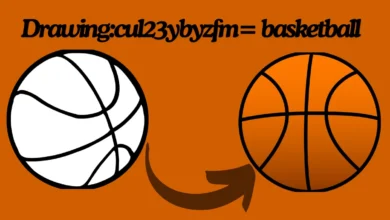Basketball, a sport drawing with agility, strategy, and raw athleticism, has inspired countless artists to capture its dynamic essence on canvas, paper, and digital screens. Drawing basketball scenes isn’t just about sketching players in motion; it’s about encapsulating the spirit of the game, the intensity of competition, and the beauty of athletic form. In this article, we’ll delve into the techniques, tips, and tricks to master the art of drawing basketball, whether you’re a beginner or a seasoned artist.
Understanding the Basics of Basketball Drawing

Drawing basketball scenes requires a blend of anatomical knowledge, perspective skills, and an understanding of motion. Let’s break down these fundamental elements to give you a solid foundation.
Anatomy and Proportion
Before diving into the intricate details of a basketball player in action, understanding human anatomy and proportions is crucial. Basketball players, with their unique physiques, offer a fascinating challenge for artists. Start with basic anatomy: study the skeletal structure, muscle groups, and how they interact during movement.
Skeleton and Muscles:
Focus on the major bones and muscles involved in basketball movements. The legs, core, and arms are particularly important, as they drive the actions of running, jumping, and shooting.
Proportional Guidelines:
Use guidelines to maintain correct proportions. For example, the height of a basketball player is usually about 7-8 heads tall. Use this as a benchmark to maintain realistic proportions.
Dynamic Poses and Movement
Basketball is all about movement—fast, dynamic, and often unpredictable. Capturing this fluidity in your drawings can be challenging but incredibly rewarding.
Action Lines:
Use action lines to show motion and direction. These lines help convey the energy and speed of the game.
Pose Reference:
Use photographs or videos of basketball players in action. Observe their posture, the angle of their limbs, and the way their bodies twist and turn during different movements.
Perspective and Composition
Understanding perspective is key to making your basketball drawings look realistic. Whether it’s a slam dunk from a bird’s-eye view or a tight close-up of a player’s face, perspective adds depth and dimension.
One-Point vs. Two-Point Perspective:
Start with simple perspectives. For example, a slam dunk is often depicted in one-point perspective, focusing on the basket as the vanishing point.
Dynamic Angles:
Experiment with different angles to create more dynamic compositions. A low angle looking up at a player can make them appear more heroic and powerful.
Tools and Materials for Basketball Drawing
Choosing the right tools and materials can significantly impact the quality of your artwork. Here’s a guide to help you pick the best ones for drawing basketball scenes.
Essential Drawing Tools
From pencils to digital tablets, the right tools can make all the difference. Here’s a rundown of what you might need:
Pencils:
Start with a range of pencils from 2H to 6B. Harder pencils (2H, H) are great for light sketches and outlines, while softer pencils (B, 6B) are perfect for shading and adding depth.
Inking Pens:
For outlining, use fine liners or ink pens. Brands like Micron or Copic offer a range of nib sizes for different line weights.
Digital Tools:
If you prefer digital art, a tablet like the Wacom Cintiq or an iPad Pro with Procreate can be invaluable. These tools offer the flexibility to experiment with colors and effects.
Paper and Surfaces
Choosing the right paper can enhance the texture and finish of your drawing. Here’s what to consider:
Sketch Paper:
For initial sketches, use a good quality sketch paper. A weight of 70-100gsm is ideal for quick sketches and layering.
Drawing Paper:
For finished pieces, opt for heavier paper, like Bristol board or watercolor paper, which can handle multiple layers of shading and inking without warping.
Additional Materials
Consider incorporating various media to add texture and depth to your drawings:
Charcoal and Pastels:
These materials can add a dramatic flair, especially for shading and highlighting.
Markers and Colored Pencils:
For adding color, markers and colored pencils are excellent choices. They allow for vibrant, precise coloring that can make your basketball drawings pop.
Techniques for Capturing the Essence of Basketball
Mastering the art of drawing basketball scenes involves a variety of techniques. Here, we’ll explore some essential techniques to help you bring your basketball drawings to life.
Sketching and Outlining
The first step in any drawing is the sketch. Here’s how to get started:
Light Sketching:
Begin with light, loose sketches. Use your pencil to outline the basic shapes and positions of the players, focusing on the overall composition.
Refining Details:
Gradually add details, paying attention to the nuances of movement and expression. Use reference images to ensure accuracy in the poses and anatomy.
Shading and Texturing
Shading adds depth and dimension, making your drawings look three-dimensional. Here’s how to approach shading:
Light and Shadow:
Understand the light source in your scene. Shade accordingly, using darker tones for areas in shadow and lighter tones for highlights.
Cross-Hatching and Stippling:
Use techniques like cross-hatching and stippling to create texture and depth. These methods are particularly effective for adding details to muscles, clothing, and the basketball itself.
Adding Color and Details
Once the sketch is complete, it’s time to add color and finer details:
Color Palette:
Choose a color palette that reflects the intensity and energy of the game. For instance, vibrant blues, reds, and oranges can convey the excitement of a fast-paced match.
Blending and Layering:
Use blending tools like tortillons or digital brushes to smoothly blend colors. Layering colors can add richness and depth to your drawing.
Advanced Techniques for Pro-Level Basketball Drawings
For those looking to take their basketball drawings to the next level, here are some advanced techniques and tips.
Using Reference Material
Reference photos and videos are invaluable for capturing the nuances of basketball action. Here’s how to make the most of them:
Dynamic Reference Shots:
Look for photos that capture the peak of action—players mid-air, muscles taut, and faces full of determination. These images provide the best reference for dynamic poses.
Video Reference:
Watching game footage can help you understand the flow of movements and the timing of actions. Pause and sketch key moments to study the anatomy and motion in detail.
Experimenting with Styles
Developing your unique style can set your basketball drawings apart. Here’s how to experiment with different styles:
Cartoon vs. Realistic:
Try blending cartoonish exaggerations with realistic details. For example, you could exaggerate the muscles and expressions while maintaining realistic anatomy.
Mixed Media:
Combine different media—pencil, ink, digital effects, and traditional painting. This mix can create a unique texture and visual interest.
Enhancing with Digital Tools
Digital tools offer a plethora of possibilities for enhancing your basketball drawings. Here’s how to leverage them:
Layering in Digital Software:
Use layers in software like Photoshop or Procreate to separate different elements of your drawing. This makes editing and refining easier.
Digital Brushes and Effects:
Experiment with digital brushes and effects to add textures, lighting effects, and dynamic backgrounds. This can give your drawings a polished, professional finish.
Creating a Basketball-Themed Artwork Series
If you’re passionate about basketball drawing, consider creating a series of artworks. This can be a fantastic way to showcase your skills and tell a story through your art.
Conceptualizing Your Series
Start with a clear concept or theme for your series. Here’s how to brainstorm and plan your artwork:
Storyboarding:
Sketch out a storyboard for your series. Plan the sequence of drawings, the key moments you want to capture, and how each piece will flow into the next.
Diverse Perspectives:
Include a variety of perspectives and scenes—action shots, portraits, fan interactions, and game-changing moments. This diversity will make your series more engaging.
Executing Your Series
With a plan in place, it’s time to bring your vision to life. Here’s how to stay organized and maintain quality:
Consistent Style:
While experimenting with different elements, maintain a consistent style. This consistency ties your series together, making it feel cohesive.
Feedback and Iteration:
Share your work with peers or online communities for feedback. Use constructive criticism to refine your drawings and improve your series.
Showcasing and Sharing Your Basketball Art
Once your drawings are complete, it’s time to share them with the world. Here’s how to showcase your basketball art effectively:
Building an Online Portfolio
An online portfolio is essential for reaching a wider audience. Here’s how to create and promote it:
Website or Blog:
Create a dedicated website or blog to showcase your artwork. Platforms like Squarespace or WordPress offer user-friendly templates to get you started.
Social Media Presence:
Use social media platforms like Instagram, Pinterest, and Twitter to share your work. Engage with basketball and art communities to build a following.
Participating in Exhibitions and Competitions
Exhibitions and competitions can provide great exposure for your work. Here’s how to get involved:
Local Art Shows:
Look for local art shows or sports-themed exhibitions. These venues are perfect for showcasing your basketball art.


